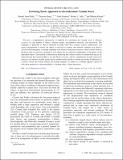| dc.contributor.author | Rahi, Sahand Jamal | |
| dc.contributor.author | Emig, Thorsten | |
| dc.contributor.author | Graham, Noah | |
| dc.contributor.author | Jaffe, Robert L. | |
| dc.contributor.author | Kardar, Mehran | |
| dc.date.accessioned | 2010-03-10T19:45:17Z | |
| dc.date.available | 2010-03-10T19:45:17Z | |
| dc.date.issued | 2009-10 | |
| dc.date.submitted | 2009-08 | |
| dc.identifier.issn | 1550-2368 | |
| dc.identifier.issn | 1550-7998 | |
| dc.identifier.uri | http://hdl.handle.net/1721.1/52477 | |
| dc.description.abstract | We give a comprehensive presentation of methods for calculating the Casimir force to arbitrary accuracy, for any number of objects, arbitrary shapes, susceptibility functions, and separations. The technique is applicable to objects immersed in media other than vacuum, nonzero temperatures, and spatial arrangements in which one object is enclosed in another. Our method combines each object’s classical electromagnetic scattering amplitude with universal translation matrices, which convert between the bases used to calculate scattering for each object, but are otherwise independent of the details of the individual objects. The method is illustrated by rederiving the Lifshitz formula for infinite half-spaces, by demonstrating the Casimir-Polder to van der Waals crossover, and by computing the Casimir interaction energy of two infinite, parallel, perfect metal cylinders either inside or outside one another. Furthermore, it is used to obtain new results, namely, the Casimir energies of a sphere or a cylinder opposite a plate, all with finite permittivity and permeability, to leading order at large separation. | en |
| dc.language.iso | en_US | |
| dc.publisher | American Physical Society | en |
| dc.relation.isversionof | http://dx.doi.org/10.1103/PhysRevD.80.085021 | en |
| dc.rights | Article is made available in accordance with the publisher's policy and may be subject to US copyright law. Please refer to the publisher's site for terms of use. | en |
| dc.source | APS | en |
| dc.title | Scattering theory approach to electrodynamic Casimir forces | en |
| dc.type | Article | en |
| dc.identifier.citation | Rahi, Sahand Jamal et al. “Scattering theory approach to electrodynamic Casimir forces.” Physical Review D 80.8 (2009): 085021. © 2009 The American Physical Society | en |
| dc.contributor.department | Massachusetts Institute of Technology. Center for Theoretical Physics | en_US |
| dc.contributor.department | Massachusetts Institute of Technology. Department of Physics | en_US |
| dc.contributor.approver | Jaffe, Robert L. | |
| dc.contributor.mitauthor | Rahi, Sahand Jamal | |
| dc.contributor.mitauthor | Emig, Thorsten | |
| dc.contributor.mitauthor | Jaffe, Robert L. | |
| dc.contributor.mitauthor | Kardar, Mehran | |
| dc.relation.journal | Physical Review D | en |
| dc.eprint.version | Final published version | en |
| dc.type.uri | http://purl.org/eprint/type/JournalArticle | en |
| eprint.status | http://purl.org/eprint/status/PeerReviewed | en |
| dspace.orderedauthors | Rahi, Sahand Jamal; Emig, Thorsten; Graham, Noah; Jaffe, Robert L.; Kardar, Mehran | en |
| dc.identifier.orcid | https://orcid.org/0000-0002-0262-3645 | |
| dc.identifier.orcid | https://orcid.org/0000-0002-1112-5912 | |
| mit.license | PUBLISHER_POLICY | en |
| mit.metadata.status | Complete | |
